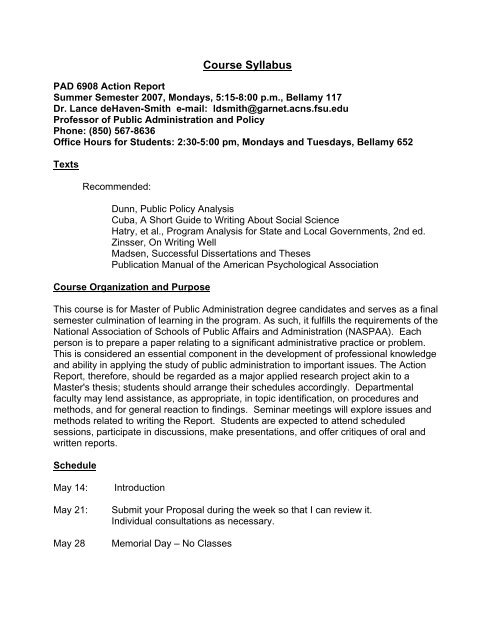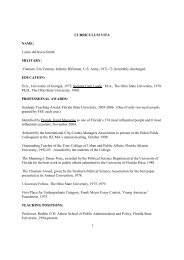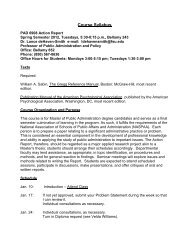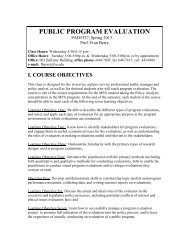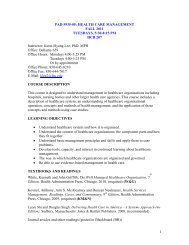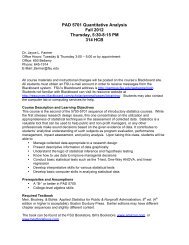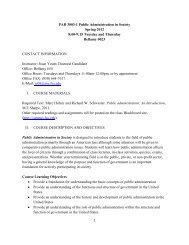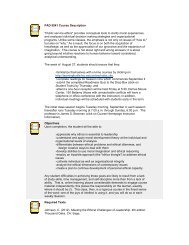Course Syllabus - Askew School of Public Administration and Policy ...
Course Syllabus - Askew School of Public Administration and Policy ...
Course Syllabus - Askew School of Public Administration and Policy ...
Create successful ePaper yourself
Turn your PDF publications into a flip-book with our unique Google optimized e-Paper software.
<strong>Course</strong> <strong>Syllabus</strong><br />
PAD 6908 Action Report<br />
Summer Semester 2007, Mondays, 5:15-8:00 p.m., Bellamy 117<br />
Dr. Lance deHaven-Smith e-mail: ldsmith@garnet.acns.fsu.edu<br />
Pr<strong>of</strong>essor <strong>of</strong> <strong>Public</strong> <strong>Administration</strong> <strong>and</strong> <strong>Policy</strong><br />
Phone: (850) 567-8636<br />
Office Hours for Students: 2:30-5:00 pm, Mondays <strong>and</strong> Tuesdays, Bellamy 652<br />
Texts<br />
Recommended:<br />
Dunn, <strong>Public</strong> <strong>Policy</strong> Analysis<br />
Cuba, A Short Guide to Writing About Social Science<br />
Hatry, et al., Program Analysis for State <strong>and</strong> Local Governments, 2nd ed.<br />
Zinsser, On Writing Well<br />
Madsen, Successful Dissertations <strong>and</strong> Theses<br />
<strong>Public</strong>ation Manual <strong>of</strong> the American Psychological Association<br />
<strong>Course</strong> Organization <strong>and</strong> Purpose<br />
This course is for Master <strong>of</strong> <strong>Public</strong> <strong>Administration</strong> degree c<strong>and</strong>idates <strong>and</strong> serves as a final<br />
semester culmination <strong>of</strong> learning in the program. As such, it fulfills the requirements <strong>of</strong> the<br />
National Association <strong>of</strong> <strong>School</strong>s <strong>of</strong> <strong>Public</strong> Affairs <strong>and</strong> <strong>Administration</strong> (NASPAA). Each<br />
person is to prepare a paper relating to a significant administrative practice or problem.<br />
This is considered an essential component in the development <strong>of</strong> pr<strong>of</strong>essional knowledge<br />
<strong>and</strong> ability in applying the study <strong>of</strong> public administration to important issues. The Action<br />
Report, therefore, should be regarded as a major applied research project akin to a<br />
Master's thesis; students should arrange their schedules accordingly. Departmental<br />
faculty may lend assistance, as appropriate, in topic identification, on procedures <strong>and</strong><br />
methods, <strong>and</strong> for general reaction to findings. Seminar meetings will explore issues <strong>and</strong><br />
methods related to writing the Report. Students are expected to attend scheduled<br />
sessions, participate in discussions, make presentations, <strong>and</strong> <strong>of</strong>fer critiques <strong>of</strong> oral <strong>and</strong><br />
written reports.<br />
Schedule<br />
May 14:<br />
May 21:<br />
May 28<br />
Introduction<br />
Submit your Proposal during the week so that I can review it.<br />
Individual consultations as necessary.<br />
Memorial Day – No Classes
June 4:<br />
June 11:<br />
June 18:<br />
June 25:<br />
July 2:<br />
July 9:<br />
July 16:<br />
July 23<br />
July 30:<br />
Plan to attend class unless you are notified that your project is approved.<br />
Turn in Diploma request (see Velda Williams).<br />
Individual consultations, as necessary.<br />
Individual consultations, as necessary.<br />
Attend class to submit 1 st draft <strong>of</strong> report.<br />
Individual consultations, as necessary.<br />
Individual consultations, as necessary.<br />
Attend class to submit 2 nd draft <strong>of</strong> report.<br />
Individual consultations, as necessary.<br />
Make formal presentations to class.<br />
Last day to submit final report.<br />
Submission Requirements<br />
All papers should be stapled in the upper left h<strong>and</strong> corner <strong>and</strong> submitted in a "two pocket"<br />
folder. In the left section, place the most recent instructor-corrected copy (earlier drafts<br />
should not be included); in the right section, the newest draft with appropriate checklist.<br />
Be sure to put your telephone number(s) <strong>and</strong> e-mail address on the front <strong>of</strong> the folder.<br />
This class is structured to ensure progress toward course completion <strong>and</strong> relies on<br />
individual consultations <strong>and</strong> student presentations. Not meeting deadlines demonstrates<br />
inadequate planning. Please do not ask for special favors; brief extensions will be granted<br />
only on the basis <strong>of</strong> extreme, documented emergencies.<br />
Do not expect the instructor to copyedit <strong>and</strong> pro<strong>of</strong> your work. Names <strong>of</strong> pro<strong>of</strong> readers <strong>and</strong><br />
editors can be obtained from the English Department (644-4230).<br />
Action Report St<strong>and</strong>ards<br />
The MPA Program is to "produce pr<strong>of</strong>essionals capable <strong>of</strong> intelligent <strong>and</strong> creative<br />
analysis, communication, <strong>and</strong> action in the public sector context." The Action Report, as<br />
noted earlier, is the capstone <strong>of</strong> this educational experience. Accordingly, it provides the<br />
opportunity for students to demonstrate ability to define <strong>and</strong> diagnose decision situations,<br />
collect relevant data, perform logical analysis, develop alternatives, implement a course <strong>of</strong><br />
action, <strong>and</strong> evaluate results; organize <strong>and</strong> communicate clearly to a variety <strong>of</strong> audiences<br />
through formats including verbal presentations, technical reports, <strong>and</strong> statistical charts,<br />
graphs, <strong>and</strong> tables (NASPAA St<strong>and</strong>ards).
Action Report Layout<br />
The Report should be: from 25 to 35 manuscript pages (plus appendices), pr<strong>of</strong>essionally<br />
typed <strong>and</strong> <strong>of</strong> a quality comparable to a monograph published by university service<br />
bureaus, government agencies, legislative committees, or pr<strong>of</strong>essional organizations.<br />
Following the title page, letter <strong>of</strong> transmittal, table <strong>of</strong> contents, <strong>and</strong> a brief executive<br />
summary (describing the problem, the methods used in the study, alternatives considered,<br />
<strong>and</strong> the recommended action), the Report should be presented as described below.<br />
I. Problem Statement (two pages in a 30-page report (not including front matter,<br />
references, <strong>and</strong> appendices))<br />
• Concise statement <strong>of</strong> the problem or question being investigated;<br />
• Brief discussion <strong>of</strong> issues surrounding the problem <strong>and</strong>/or proposed actions<br />
• Explanation <strong>of</strong> why the problem or question is significant in public administration.<br />
II. Background <strong>and</strong> Literature Review (about six pages)<br />
• Background<br />
o The nature <strong>of</strong> the problem should be elaborated. How did the problem<br />
evolve How has it changed over time<br />
o What is the current status <strong>of</strong> the problem<br />
o Specify the context in which the problem occurs <strong>and</strong> its timeliness for public<br />
administration.<br />
• Literature Review<br />
o Summarize the literature. Include academic research <strong>and</strong> major reports <strong>of</strong><br />
government agencies.<br />
o Describe how the present study relates to existing literature. What<br />
guidance does the literature provide What issues remain that are pertinent<br />
to the problem under analysis<br />
III. Research Methodology <strong>and</strong> Evaluative Criteria (about two pages)<br />
• Research Methodology<br />
o State the procedures, methods, <strong>and</strong> basic assumptions to be followed<br />
(regardless <strong>of</strong> the quantitative/qualitative character <strong>of</strong> the study); define<br />
terms, in a footnote, that are subject to multiple meaning.<br />
o Describe methods <strong>of</strong> collecting, analyzing <strong>and</strong> treating data, that is, the<br />
research design.
• Evaluative Criteria<br />
o Indicate clearly the criteria (<strong>and</strong> appropriate indicators <strong>and</strong> data sources for<br />
each) to be used in evaluating the management policy options.<br />
o Discuss any methodological weaknesses that might affect the reliability <strong>and</strong><br />
validity <strong>of</strong> the findings.<br />
IV. <strong>Policy</strong> Options (about 10-15 pages)<br />
Present the policy options that are to be evaluated. Ensure that the options are presented<br />
in a logical, clear, <strong>and</strong> well-written manner. They should directly address the problem<br />
posed in the title <strong>of</strong> the paper. Utilize the literature referenced in Part II. Systematically<br />
employ the evaluation criteria identified in Part III.<br />
V. Conclusion/Recommendation for Action (about two pages)<br />
<strong>Public</strong> <strong>of</strong>ficials must <strong>of</strong>ten make decisions based upon limited information; therefore, you<br />
must develop a carefully fashioned conclusion, even though the findings may be<br />
somewhat inconclusive. Choose one <strong>of</strong> the options (or combination <strong>of</strong> options) examined<br />
in Part IV, summarize the reasons for reaching that decision (including why the other<br />
options are not adequate), <strong>and</strong> defend your selection by relating it directly to the original<br />
problem.<br />
Optional Format<br />
A similar, alternative format for the Report--consisting <strong>of</strong> an Introduction, Methodology,<br />
Findings, Discussion, <strong>and</strong> Options/Recommendations section--is permissible. Consult<br />
with the instructor regarding the <strong>School</strong>'s file <strong>of</strong> past Action Reports.<br />
The FSU Honor Code<br />
Students are expected to uphold the Academic Honor Code published in the Florida State<br />
University Bulletin <strong>and</strong> the Student H<strong>and</strong>book. The Academic Honor Code <strong>of</strong> The Florida<br />
State University requires students to (1) uphold the highest st<strong>and</strong>ards <strong>of</strong> academic<br />
integrity in their own work, (2) refuse to tolerate violations <strong>of</strong> academic integrity in the<br />
university community, <strong>and</strong> (3) foster a high sense <strong>of</strong> integrity <strong>and</strong> social responsibility.<br />
Violations <strong>of</strong> the Academic Honor Code are delineated in Chapter 8 <strong>of</strong> the Faculty<br />
H<strong>and</strong>book, as follows (8.22.1 (b) ):<br />
..<br />
1. During examinations, violations <strong>of</strong> the Academic Honor Code shall include referring<br />
to information not specifically condoned by the instructor. It shall further include<br />
receiving information from a fellow student or another unauthorized source.<br />
2. Regarding academic assignments, violations <strong>of</strong> the Academic Honor Code shall<br />
include representing another's work or any part there<strong>of</strong>, be it published or<br />
unpublished, as one's own. It shall also include presenting or submitting any
academic work in a manner that impairs the instructor's ability to assess the<br />
student's academic performance. For example, plagiarism includes failure to use<br />
quotation marks or other conventional markings around material quoted from any<br />
source.<br />
3. Violations <strong>of</strong> the Academic Honor Code shall include obtaining, distributing, or<br />
referring to a copy <strong>of</strong> an examination which the instructor/department has not<br />
authorized to be made available for such purpose.<br />
4. Violations <strong>of</strong> the Academic Honor Code shall include any act which impedes the<br />
ability <strong>of</strong> other students to have fair access to materials assigned or suggested by<br />
the instructor. For example, removal or destruction <strong>of</strong> library or other source<br />
materials violates the Academic Honor Code.<br />
5. Academic dishonesty shall include tampering with another student's work or<br />
impairing in any way the instructor's ability to assess the academic performance <strong>of</strong><br />
another student.<br />
6. Violations <strong>of</strong> the Academic Honor Code shall include alteration <strong>of</strong> grades or any<br />
other records related to the academic performance <strong>of</strong> students. This shall also<br />
include submitting any false records in order to gain admission to the University.<br />
7. Violations <strong>of</strong> the Academic Honor Code shall include assisting, attempting to assist,<br />
or conspiring to assist another student in committing the <strong>of</strong>fenses as outlined<br />
above.<br />
8. Violations <strong>of</strong> the Academic Honor Code shall include attempting to commit any<br />
<strong>of</strong>fense as outlined above.<br />
Students should pay special attention to paragraph 2, above. Plagiarism on any<br />
assignment in this course will result in a failing grade for the assignment <strong>and</strong> may result in<br />
a failing grade for the course.<br />
ADA <strong>Policy</strong><br />
Students with disabilities needing academic accommodation should (1) register<br />
with <strong>and</strong> provide documentation to the Student Disability Resource Center; <strong>and</strong> (2) bring a<br />
letter to the pr<strong>of</strong>essors indicating the need for accommodation <strong>and</strong> what type. This should<br />
be done during the<br />
Grades<br />
Grades for the course will be based on a multidimensional evaluation <strong>of</strong> the Action<br />
Report. The criteria <strong>and</strong> the weight assigned to them are as follows:<br />
Conceptualization (30%)<br />
Clarity, cogency <strong>of</strong> problem statement.<br />
Relevance <strong>and</strong> range <strong>of</strong> evaluative criteria.<br />
Research (30%)
Scope <strong>and</strong> organization <strong>of</strong> literature review<br />
Quality <strong>of</strong> data collection, analysis, <strong>and</strong> interpretation<br />
Recommendations (10%)<br />
Consistency in application <strong>of</strong> evaluative criteria.<br />
Appropriateness <strong>of</strong> conclusions <strong>and</strong> recommendations.<br />
Presentation (30%)<br />
Quality <strong>of</strong> writing<br />
Quality <strong>of</strong> speaking<br />
Grade equivalencies are: 100-93=A, 92-90=A-. 89-87=B+, 86-83=B, 82-80=B-, 79-<br />
77=C+, 76-73=C, 72-70=C-, 69-67=D+, 66-63=D, 62-60=D-, 59-0=F. In the computation<br />
<strong>of</strong> final grades, all decimals from .5 <strong>and</strong> above are rounded up, <strong>and</strong> all below this are<br />
rounded down.


